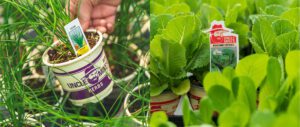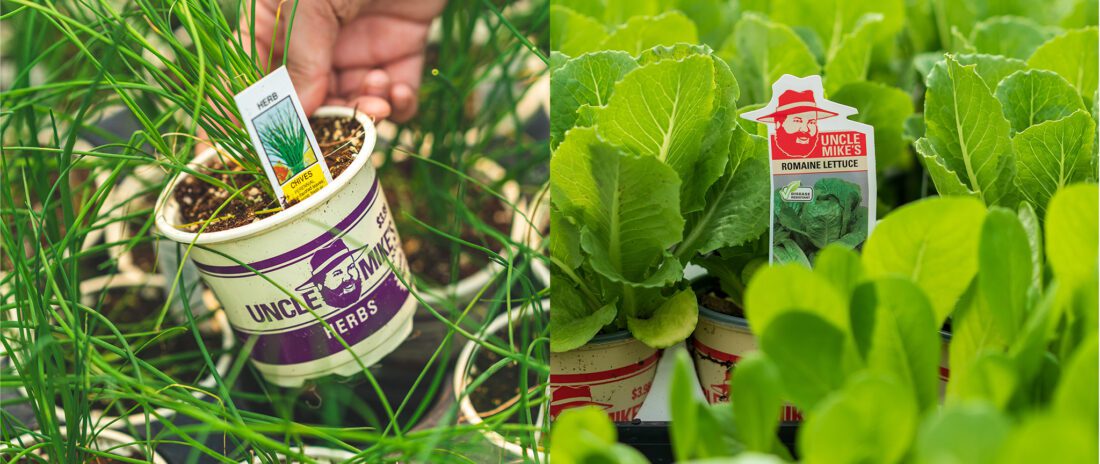September 12, 2024
Planting Cold Crops in the Fall: What to Grow and How to Harvest
Fall is a great time to plant cold crops that thrive in cooler temperatures and give you a fresh, healthy harvest well into the colder months. These vegetables and herbs are perfect for extending your gardening season and adding vibrant greens and flavors to your fall meals. If you’re looking to grow cold-hardy crops, the following are ideal choices for fall planting:
- Arugula
- Broccoli Raab
- Bok Choi
- Cabbage & Chinese Cabbage
- Kale (Toscano & Vates)
- Lettuce (Buttercrunch, Mesclun & Romaine)
- Peas (Tall Telephone, Sugar Snap & Dwarf Grey Sugar)
- Swiss Chard (Fordhook Giant & Bright Lites)
- Chives
- Mints (Mojito, Chocolate & Spearmint)
- Oregano (Greek & Italian)
- Sage (Bergarten, Grey, Icterina, Tricolor)
- Tarragon
- Culinary Thyme (Lemon, French, English)
Let’s dive into why fall is the perfect time to plant cold crops and some helpful tips on harvesting them.

Why Plant Cold Crops in the Fall?
- Cooler Temperatures for Optimal Growth: Many cold crops prefer cooler weather and actually thrive in fall conditions. With lower daytime temperatures and crisp nights, these crops grow with less heat stress compared to summer months.
- Frost Tolerance: Some cold crops can handle light frosts, which can enhance their flavor, particularly in leafy greens like kale and Swiss chard. As the temperature dips, the starches in the plants convert to sugars, making them taste sweeter.
- Fewer Pests: The fall season brings relief from some common garden pests that can wreak havoc on crops in the warmer months, allowing for healthier plants and more abundant harvests.
- Extended Harvest Season: By planting these crops in the fall, you can extend your garden’s productivity right up until winter, giving you a longer period to enjoy fresh, homegrown produce.
Cold Crops to Plant This Fall
Arugula
Why Plant: Arugula grows fast and adds a peppery flavor to salads and sandwiches. It thrives in cool temperatures and can be harvested multiple times during the fall.
Harvest Tip: Pick the outer leaves when they are 3-4 inches long for continuous growth. Younger leaves are milder, while older ones have a more intense flavor.
Broccoli Raab
Why Plant: This fast-growing crop is perfect for fall, offering edible stems, leaves, and buds that are packed with nutrients
Harvest Tip: Harvest when the flower buds begin to form but before they fully open. Cut the main stem to encourage more side shoots for multiple harvests.
Bok Choi
Why Plant: Bok Choi is a versatile crop that prefers cool temperatures and can grow quickly in fall conditions.
Harvest Tip: You can harvest baby bok choi when it reaches about 6 inches in height, or wait for full-sized plants. Always cut at the base, leaving the roots for possible regrowth.
Cabbage & Chinese Cabbage
Why Plant: Both traditional and Chinese cabbage are cold-hardy and can produce large heads even with light frosts.
Harvest Tip: Harvest the heads when they are firm and compact. You can store them in cool conditions for several weeks after picking.
Kale
Why Plant: Kale thrives in the fall, becoming sweeter after the first frost. It’s a nutrient-dense green that grows well in cool weather.
Harvest Tip: Harvest the outer leaves as needed, leaving the inner leaves to continue growing. Frost makes the leaves sweeter, so don’t rush to pick them all before the temperatures drop.
Lettuce
Why Plant: Lettuce grows quickly and can be planted multiple times in the fall for successive harvests.
Harvest Tip: Cut leaves when they are 3-6 inches tall for baby greens, or let the entire plant mature for a full head harvest.
Peas
Why Plant: Peas are a great cold crop that can tolerate light frosts and provide a sweet harvest even in the fall.
Harvest Tip: Harvest pea pods when they are plump but not overly mature. Pick regularly to encourage more production.
Swiss Chard
Why Plant: Swiss chard is a beautiful, colorful crop that grows well in cool temperatures and can withstand light frost.
Harvest Tip: Pick the outer leaves when they are young and tender, allowing the plant to continue producing throughout the fall.
Herbs for Fall Planting
Chives
Why Plant: Chives are a hardy perennial that can be grown in the fall and provide a fresh, onion-like flavor to dishes.
Harvest Tip: Snip the leaves when they are at least 6 inches tall, and leave the plant’s base intact for continuous regrowth.
Mints
Why Plant: Mint is a resilient herb that thrives in cooler weather and can grow abundantly in fall.
Harvest Tip: Harvest mint regularly by cutting the stems just above a pair of leaves to encourage bushier growth.
Oregano
Why Plant: Oregano is a cold-hardy herb that can continue producing well into fall.
Harvest Tip: Trim the stems before the plant flowers for the best flavor, and use fresh or dry for long-term storage.
Sage
Why Plant: Sage is another hardy perennial herb that benefits from cooler weather, offering a rich, earthy flavor.
Harvest Tip: Pick individual leaves as needed or harvest entire stems just before flowering for the strongest flavor.
Tarragon
Why Plant: Tarragon prefers cooler temperatures and adds a unique, anise-like flavor to your culinary dishes.
Harvest Tip: Harvest tarragon leaves in the morning, before the sun intensifies, to capture the best flavor. Cut the stems and hang them to dry for later use.
Culinary Thyme
Why Plant: Thyme is a low-maintenance herb that grows well in cooler weather and adds depth to your dishes.
Harvest Tip: Harvest thyme just before the plant flowers for the most potent flavor. Snip small stems regularly to encourage new growth.

Tips for a Successful Fall Harvest
- Monitor Frost: While many cold crops can handle a light frost, keep an eye on the weather and use row covers or mulch to protect your plants from hard freezes.
- Succession Planting: To ensure a continuous harvest, plant cold crops in intervals throughout the fall. This way, you’ll always have something fresh and ready to pick.
- Water Consistently: While temperatures may cool, your plants still need consistent watering to thrive. Avoid letting the soil dry out completely.
- Mulch for Protection: Applying mulch can help regulate soil temperatures and protect your plants from frost while retaining moisture.
Final Thoughts
Planting cold crops in the fall is a fantastic way to keep your garden going as the weather cools down. With proper care, you’ll enjoy a variety of fresh greens, herbs, and veggies right up until winter. The best part? Cold crops often taste even better after a light frost, giving you a delicious, nutrient-packed harvest.
Visit Mahoney’s Garden Center for all the cold crop seeds, plants, and gardening supplies you need to keep your fall garden thriving!
SHOP NOW

